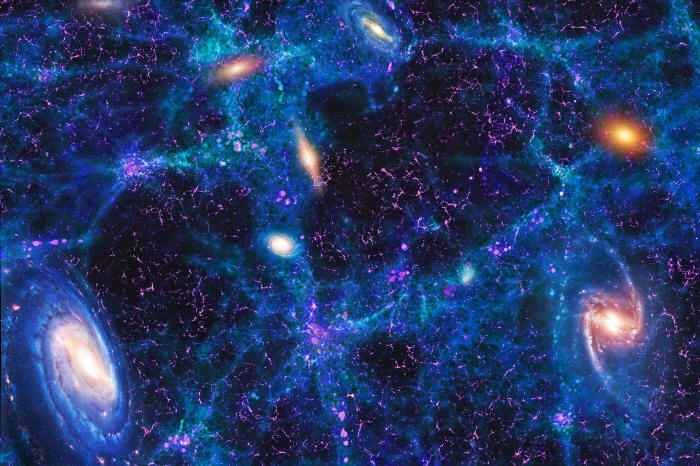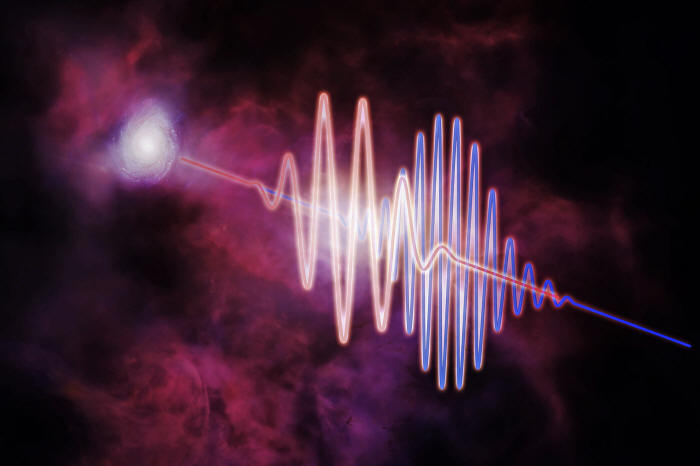|

by Robert Lea and
SPACE.com
June 17, 2025
from
ScientificAmerican Website
|
Robert Lea
is a science
journalist in the U.K. whose articles have been
published in Physics World, New Scientist, Astronomy
Magazine, All About Space, Newsweek and ZME Science.
He also writes
about science communication for Elsevier and the
European Journal of Physics.
Rob holds a
bachelor of science degree in physics and astronomy from
the U.K.'s Open University. |

Astronomers have long struggled to
see and study
the dilute,
dark gas and dust between galaxies,
depicted in
this artist's concept as blue and purple filaments
in a vast
'cosmic web.'
Mark Garlick/Science Photo Library
Getty Images
Researchers have
used
cosmic
explosions called 'fast radio bursts' (FRBs)
to illuminate
the intergalactic medium...
Half of the universe's ordinary matter was missing - until now.
Astronomers have used mysterious but powerful explosions of energy
called fast radio bursts (FRBs)
to detect the universe's missing "normal" matter for the first time.
This previously missing stuff isn't
dark matter, the mysterious
substance that accounts for around 85% of the material universe but
remains invisible because it doesn't interact with light.
Instead, it is,
ordinary matter made out of atoms (composed
of baryons) that does interact with light but has until now just
been too dark to see...
Though this puzzle might not quite get as much
attention as the dark matter conundrum - at least we knew what this
missing matter is, while the nature of dark matter is
unknown - but its
AWOL status has been a
frustrating problem in cosmology nonetheless.
The missing baryonic matter problem has persisted
because it is spread incredibly thinly through
halos that surround galaxies and in
diffuse clouds that drift in the space between galaxies.
Now, a team of astronomers discovered and accounted for this missing
everyday matter by using FRBs to illuminate wispy structures lying
between us and the distant sources of these brief but powerful
bursts of radio waves.
"The FRBs shine through the fog of the
intergalactic medium, and by precisely measuring how the light
slows down, we can weigh that fog, even when it's too faint to
see," study team leader Liam Connor, a researcher at the
Center for Astrophysics (CfA), Harvard & Smithsonian,
said in a statement.
How FRBs illuminate Missing Matter
FRBs are,
pulses of radio waves that often last for
mere milliseconds, but in this brief time they can emit as much
energy as the sun radiates in 30 years.
Their origins remain something of a mystery.
That's because the short duration of these
flashes and the fact that most occur only once make them notoriously
hard to trace back to their source.
Yet for some time, their potential to help "weigh" the matter
between galaxies has been evident to astronomers. Though thousands
of FRBs have been discovered, not all were suitable for this
purpose.
That's because, to act as a gauge of the matter
between the FRB and Earth, the energy burst has to have a localized
point of origin with a known distance from our planet.
Thus far, astronomers have only managed to
perform this localization for about 100 FRBs.
Connor and colleagues, including California Institute of
Technology (Caltech) assistant professor Vikram Ravi,
utilized 69 FRBs from sources at distances of between 11.7 million
to about 9.1 billion light-years away.
The FRB from this maximum distance, FRB
20230521B, is the
most distant FRB source ever
discovered.

This artist's concept
shows light
from a fast radio burst
on its journey
through the intergalactic medium.
Long
wavelengths, shown in red, are slowed down
compared
to shorter, bluer wavelengths,
allowing
astronomers to “weigh”
the
otherwise invisible ordinary matter.
Melissa Weiss/CfA (CC0)
Of the 69 FRBs used by the team, 39 were discovered by a network of
110 radio telescopes located at Caltech's Owen Valley Radio
Observatory (OVRO)
called the Deep Synoptic Array (DSA).
The DSA was built with the specific mission of
spotting and localizing FRBs to their home galaxies.
Once this had been done, instruments at Hawaii's
W. M. Keck Observatory and at
the
Palomar Observatory near San
Diego were used the measure the distance between Earth and these
FRB-source galaxies.
Many of the remaining FRBs were discovered by the Australian
Square Kilometer Array Pathfinder (ASKAP),
a network of radio telescopes in Western Australia that has excelled
in the detection and localization of FRBs since it began operations.
As FRBs pass through matter, the light that comprises them is split
into different wavelengths. This is just like what happens when
sunlight passes through a prism and creates a rainbow diffraction
pattern.
The angle of the separation of these different wavelengths can be
used to determine how much matter lies in the clouds or structures
that the FRBs pass through.
"It's like we're seeing the shadow of all the
baryons, with FRBs as the backlight," Ravi explained.
"If you see a person in front of you, you can
find out a lot about them. But if you just see their shadow, you
still know that they're there and roughly how big they are."
The team's results allowed them to determine
that,
approximately 76% of the universe's normal
matter lurks in the space between galaxies, known as the
intergalactic medium.
They found a further 15% is locked up in the
vast diffuse haloes around galaxies.
The remaining 9% seems to be concentrated
within the galaxies, taking the form of stars and cold galactic
gas.
The distribution calculated by the team is in
agreement with predictions delivered by advanced simulations of the
universe and its evolution, but it represents the first
observational evidence of this.
The team's results could lead to a better
understanding of how galaxies grow.
For Ravi, however, this is just the first step
toward FRBs becoming a vital tool in cosmology, aiding our
understanding of the universe.
The next step in this development may well be Caltech's planned
radio telescope, DSA-2000. This radio array, set to be constructed
in the Nevada desert, could spot and localize as many as 10,000 FRBs
every year.
This should both boost our understanding of these powerful blasts of
radio waves and increase their usefulness as probes of the
universe's baryonic matter content.
The team's research (A
Gas-rich Cosmic Web revealed by the partitioning of the Missing
Baryons) was published on Monday (June 16) in the journal
Nature Astronomy.
|



